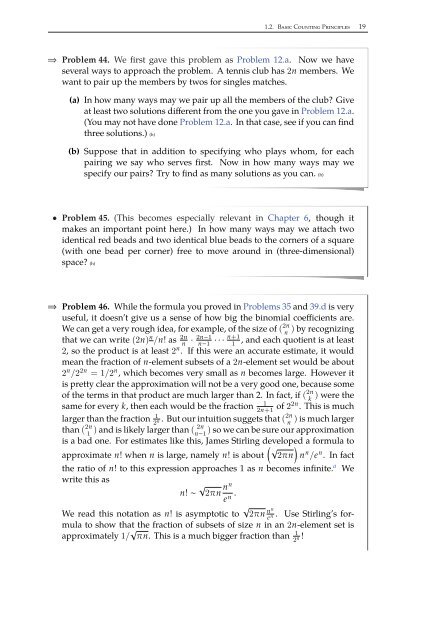Combinatorics Through Guided Discovery, 2004a
Combinatorics Through Guided Discovery, 2004a
Combinatorics Through Guided Discovery, 2004a
Create successful ePaper yourself
Turn your PDF publications into a flip-book with our unique Google optimized e-Paper software.
1.2. Basic Counting Principles 19<br />
⇒ Problem 44. We first gave this problem as Problem 12.a. Now we have<br />
several ways to approach the problem. A tennis club has 2n members. We<br />
want to pair up the members by twos for singles matches.<br />
(a) In how many ways may we pair up all the members of the club? Give<br />
at least two solutions different from the one you gave in Problem 12.a.<br />
(You may not have done Problem 12.a. In that case, see if you can find<br />
three solutions.) (h)<br />
(b) Suppose that in addition to specifying who plays whom, for each<br />
pairing we say who serves first. Now in how many ways may we<br />
specify our pairs? Try to find as many solutions as you can. (h)<br />
• Problem 45. (This becomes especially relevant in Chapter 6, though it<br />
makes an important point here.) In how many ways may we attach two<br />
identical red beads and two identical blue beads to the corners of a square<br />
(with one bead per corner) free to move around in (three-dimensional)<br />
space? (h)<br />
⇒<br />
Problem 46. While the formula you proved in Problems 35 and 39.d is very<br />
useful, it doesn’t give us a sense of how big the binomial coefficients are.<br />
We can get a very rough idea, for example, of the size of ( 2n )<br />
n<br />
by recognizing<br />
that we can write (2n) n /n! as 2n n · 2n−1 n+1<br />
n−1 ···<br />
1<br />
, and each quotient is at least<br />
2, so the product is at least 2 n . If this were an accurate estimate, it would<br />
mean the fraction of n-element subsets of a 2n-element set would be about<br />
2 n /2 2n = 1/2 n , which becomes very small as n becomes large. However it<br />
is pretty clear the approximation will not be a very good one, because some<br />
of the terms in that product are much larger than 2. In fact, if ( 2n )<br />
k<br />
were the<br />
same for every k, then each would be the fraction 1<br />
2n+1 of 22n . This is much<br />
larger than the fraction 1<br />
2<br />
. But our intuition suggets that ( 2n ) n n<br />
is much larger<br />
than ( 2n 2n<br />
)<br />
1<br />
and is likely larger than ( )<br />
n−1<br />
so we can be sure our approximation<br />
is a bad one. For estimates like this, James Stirling developed<br />
(<br />
a formula to<br />
√2πn )<br />
approximate n! when n is large, namely n! is about n n /e n .Infact<br />
the ratio of n! to this expression approaches 1 as n becomes infinite. a We<br />
write this as<br />
n! ∼ √ 2πn nn<br />
e n .<br />
We read this notation as n! is asymptotic to √ 2πn nn<br />
e<br />
. Use Stirling’s formula<br />
to show that the fraction of subsets of size n in an 2n-element set is<br />
n<br />
approximately 1/ √ πn. This is a much bigger fraction than 1<br />
2<br />
! n


















